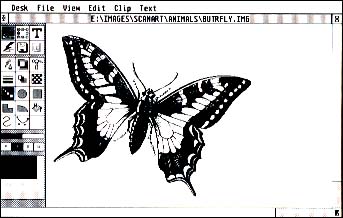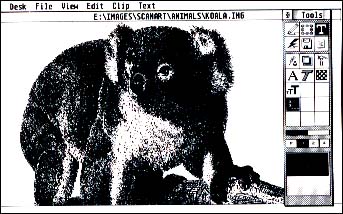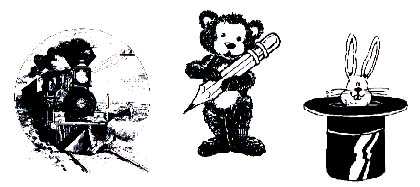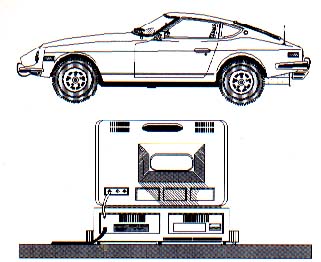Review
Great New Graphics Tools From Migraph
Easy Tools, Touch-Up, Draw Art and Scan Art
BY DAN FRUCHEY
Migraph entered the ST market three years ago with Easy Draw, a superb object-oriented graphics program that puts even MacDraw and GEM Draw to shame. While Easy Draw remains the flagship of the Migraph line, Liz and Kevin Mitchell have now published Easy Tools, Scan Art, Draw Art, and Touch-Up to complement Easy Draw.
While these four products are intended to be used with Easy Draw they can, with the exception of Easy Tools, also be used to enhance other graphics and desktop publishing programs. You'll, however, need at least one megabyte of memory and a double-sided drive to run Touch-Up or Easy Draw with Easy Tools. A double-sided drive will also be necessary to read either of the clip art collections.
 |
| You can look at objects from all angles with Easy Tools. One of its most powerful tools is the Rotator which, as you can guess, rotates objects on any axis and at any angle--and lets you duplicate and resize them during rotation. |
Easy Tools
Easy Tools is a collection of graphic tools that expand the capabilities of Easy Draw. The toolbox is packaged as a desk accessory that remains dormant until Easy Draw is loaded into memory. Then an icon appears on the screen, that allows access to Easy Tools' additional functions.
Easy Tools precisely manipulates object-oriented graphics and text. It will measure, create, duplicate, resize and rotate graphics and graphic text with little effort. It speeds up many of the mundane steps required to produce object-oriented graphics. Easy Tools will create grids of any size, precisely size and place graphics with up to 1/1,000-inch accuracy and copy graphics in any size from 1 to 999 percent of the original.
One of the most powerful tools available is the Rotator, used (as the name says) to rotate graphics. Objects can be rotated on any axis and at any angle. During rotation, objects can be duplicated and resized to create designs and patterns quickly.
GEM programs that follow the standards established by Digital Research can't rotate text, because they use GDOS fonts. This limitation is especially frustrating if you want to create rotated text banners and sidebars. Easy Tools includes a polytext function that lets you create text that can be rotated and manipulated. The rotated text can then be used in Easy Draw or exported to other programs that also succumb to this GEM limitation.
 |
| The Inquisitor feature in Easy Tools lets you enter the coordinates and dimensions for a figure in numerical form rather than using the mouse to stretch, shrink and position the figure. |
Easy Tools is an essential addition to Easy Draw for professionals who use graphics. Carpenters, architects and engineers will find this powerful tool indispensable when creating scale models or plans. Artists, designers and desktop publishers will find that Easy Tools saves time and helps avoid costly page layout mistakes. If you use Easy Draw, Easy Tools will prove to be an enjoyable addition to your system.
Touch-Up
For the last two years, I have been using a scanner to copy monochrome images. I have hundreds of scanned-in pictures and I use them quite frequently. Previously, I couldn't edit my pictures once I had scanned them. Programs like DEGAS Elite allow users only to load and edit a single screen of picture data. The pictures I had scanned in at 300 dots per inch were sometimes five times the size of a single screen.
Migraph's Supercharger addition to Easy Draw allowed some very primitive dot-by-dot editing of image files and it could clip out specific portions of a picture for use. Unfortunately, Supercharger went no further--it's an advanced picture conversion utility, not a paint program.
Enter Touch-Up, Migraph's advanced paint program and picture conversion utility rolled into one. Touch-Up can create and edit bit-mapped graphics using virtually any picture format that is currently accepted by ST and Mega computers. In addition, Touch-Up will import pictures from many non-ST formats to give you the graphics versatility of other systems.
Touch-Up works on both color and monochrome monitors. However, while you can load color images, you can only edit them as monochrome images. During the loading process, you must choose a method of converting the colors to black and white. All output is monochrome.
 |
| From images the size of a postage stamp to graphics that are five times the size of a single screen, Touch Up loads them all with out a hitch--and you can readjust the size of the working area at any time. |
Touch-Up uses the standard mouse, windows and drop-down menus every ST user has come to expect. To the left side of the working area there is also a series of icon-oriented option menus used to access the various modes.
Features, Features, Features
One of the chief attractions of this program is a freely adjustable working area. From postage stamp-sized images to graphics five times the size of a single screen, Touch-Up loads them all without a hitch. If you need more room to merge additional graphics, you can readjust the size of the working area at any time. A resizable clipboard is also available for storing and editing completed pictures or portions of pictures.
Four zoom levels are available at all times. You can zoom in for detail work or zoom out to the full page mode to obtain an overall view of pictures in progress. Most editing functions must be performed in one of the zoom modes, but overall changes like masking and use of fill patterns can be performed in the full page mode.
Touch-Up includes all of the options normally found in a paint program. You can create boxes, lines, polylines, arcs, wedges and ellipses almost automatically. Line style and thickness, shadow style and direction, brushes and fill patterns are all adjustable. Pictures can be copied, rotated, flipped, mirrored, slanted, stretched or sized using the clipboard and working area.
There are many versatile extra touches that save time and add a great deal of power to Touch-Up. These include creation of B-spline and bezier curves, masking and automatic outlining of graphics.
 |
| With Touch-Up, you can create and edit bit-mapped graphics using whatever picture format your ST can handle--and even some non-ST formats. |
One extra I found especially useful is the Clean Up mode. Scanned pictures normally contain stray pixels where the hardware picked up ghost images, smudges, or dirt. Normally a great deal of time is required to erase these individual dots so that pictures will look sharp. The Clean Up mode automatically erases stray dots on the page. If you do have scanned clip art, this mode is a real time and sanity saver.
Touch-Up uses 12 resizable vector fonts. Publishing Partner and Page Stream fans may recognize the designs as they are based on the same fonts. Any text created with Touch-Up is treated as a bit image graphic, not as editable text. This has many advantages. It can be manipulated in many ways normally inaccessible within Easy Draw and other programs that follow GEM standards. Styles available to modify the included fonts include bold, light, italics, backslant, outline, underlined, filled and fat. Text created with TouchUp consumes less memory than GDOS text and allows much more versatility. They do, however, cease to be resolution-independent when created this way.
Pictures can be loaded and saved in many ST formats including Printmaster, DEGAS/DEGAS Elite, Image and NEOchrome. You can also load and save MacPaint, PCX and TIFF graphics normally used by Apple and IBM computers. When you're finished creating your art work it can also be saved in GIF or Amiga IFF formats.
On top of these capabilities, TouchUp also includes a slide show utility, direct output to printers via GDOS, the ability to lock modes in place, tear-away menus, editable file paths, sample graphics and a utility that speeds up mouse movements.
Touch-Up is a powerful design tool at is a suitable companion for any graphics or publishing software you own. What Easy Draw is to object-oriented graphics, Touch-Up is to bitmapped graphics. The program can be compared favorably to MacPaint, PC Paint and other high resolution paint programs on those other systems. For the casual user, Touch-Up might be a bit option-heavy, but for the professional user Touch-Up has all the power you need.
Migraph is helping to broaden acceptance of the ST by supporting importation and exportation of non-ST standard graphics formats. Many collections of graphics already exist on other systems and now it is possible to retain the power of an ST and still have the graphics selection other computer owners boast about.
I am extremely impressed with Touch-Up; it is a quality product that will definitely save time on desktop publishing and graphics projects.
Away With the PSK?
A controversy has arisen over Migraph's use of a Program Security Key (PSK) with Touch-Up. The PSK, sometimes referred to as a "dongle" (don't ask me why), must be plugged into the parallel port first or Touch-Up won't run. It does not interfere with your printer or any other programs.
The PSK should limit piracy of Touch-Up, while still letting you load the program onto a hard disk. I have mixed feelings about it. While I don't believe application programs should be copy-protected, I'll take the bad with the good and Touch-Up is very good.
Scan Art
Scan Art is a collection of monochrome bit-mapped images (clip art) obtained from popular design resources. The scanned pictures have been edited extensively to provide crisp, clean output. The collection comes on two double sided disks and has over one hundred graphics with themes such as animals, food, holidays, the office, performing arts, school, sports and transportation.
The images are saved in GEM Image format (.IMG) and can be used with most publishing and graphics programs and in those word processors that import graphics. The pictures can be used with programs that run in any screen resolution without resorting to conversion utilities.
 |
| Scan Art monochrome bit-mapped images, edited extensively to provide crisp, clean output. Scan Art has over 100 graphics with themes such as animals, food, holidays, the office, performing arts, school, sports and transportation. |
Scan Art has saved me many hours of searching for appropriate graphics. I frequency use Scan Art in the newsletters and brochures I create for clients and friends. Creating commercial publications? Don't worry. Scan Art can be used in your projects without copyright infringement (a potential problem with public domain pictures).
A catalog included with Scan Art shows each graphic. There's also an index that lists their dimensions. This well-documented product will make an excellent addition to any clip art collection.
Remember, however, that Scan Art is sold only on double-sided disks. If you have only a single-sided drive, you will have to ask a friend or cooperative dealer to copy them to single-sided disks.
Draw Art
While Scan Art is composed of bit-mapped images, Draw Art is a collection of object-oriented clip art drawn by graphic artist Tom Ethen. The collection of over one hundred images comes on two double-sided disks, thus raising the same potential problems as Scan Art. Its themes include animals, arrows, borders, buildings, computers, maps, office equipment, sports equipment and tools.
Because Draw Art is object-oriented, its graphics can be "disassembled" and used in many different ways. As an example the front wall of a house can be removed to reveal an interior presented in three-dimensional realism. You can remove the lens from a 35mm camera image to show the shutter planes; the possibilities are endless. This ability is unique to object-oriented graphics and has tremendous potential.
 |
| Draw Art images are object-oriented clip art. They're not as crisp as the Scan Art images, but they're far more flexible. |
Graphics for almost every conceivable application are included in the collection. From baseball bats for little league flyers to detailed houses for real estate ads, Draw Art is an exceptional collection of high-quality artwork.
A catalog of the pictures is included, along with hints and ideas on using and displaying Draw Art.
Object-oriented graphics (also called vector graphics) have another distinct advantage over bit-mapped graphics. Bit-mapped graphics can only be enlarged to a certain point before their lines and curves display jagged stair-step patterns that make them look blocky and unattractive. Vector graphics are saved as shape and pattern definitions rather than pixel-by-pixel bitmapped images and thus can be resize endlessly without a loss in resolution or detail. When changes are made in an object-oriented graphic the computer recalculates the relationships between objects and optimizes each component so that the pictures will look their best no matter what screen resolution or output device is used.
I have yet to find a project where I have not used some form of object-oriented graphic. Draw Art is an invaluable addition to my graphics library. It speeds up projects and allows me many variations in design. Creating object-oriented art is a time-consuming task; using Draw Art is quick and painless.
And In Conclusion. . .
Even Siskel and Ebert would offer "Two Thumbs Up" for these four outstanding efforts by Migraph. They're that good.
Dan Fruchey, formally the desktop publishing columnist for ST Applications, works as a paramedic in Santa Rosa, California and runs a small clip-art business on the side.
PRODUCTS MENTIONED
Draw Art, $69.95; Easy Tools, $49.95. Scan Art, $49.95; and Touch-Up, $179.95. Migraph, Inc., 200 S. 333 Suite #220, Federal Way, WA 98003, (206) 838-4677 for information or (800) 223-3729 for orders.